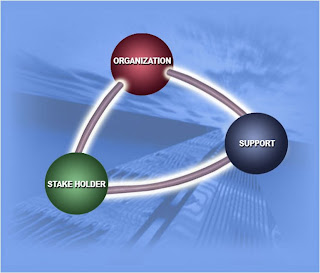 The eBusiness Model
The eBusiness ModelThe three legs of the business relationship are shown in the above graphic. The three big roles are; the organization (business), the support (administration) and the stakeholder (customer). For hundreds of years these three roles have had a known and predictable inter-relationship.
If you wanted a product you engaged the organization either by store front or by phone. The traditional model has you engaging in a salesperson/client role. You discuss the product, features, benefits and costs. When the parties agree to proceed to the next step, that step is typically a sale. The salesperson will lead the customer to administrative support and make the initial introductions in some form. In a lot of cases, the sales cycle is over and then the support cycle begins. Now the customer will likely get exposed to the support functions of an organization. This is a tenuous situation. A good salesperson is trained in the craft of customer relations and has a positive (at least the successful ones) attitude. They are typically motivated by the commission of the sale and are eager to pass you on to the administrative group. This can problematic due to the fact the administrative layer is motivated by following the internal process and reducing their effort to complete the task. This can become the first strain on the customer relationship.
If you look at the triangle the cycle goes likes this; the customer (stakeholder) talks to the salesperson (business representative) that passes the sales info to support and the customer pays the support person to complete the transaction.
This model has worked for hundreds, if not thousands of years.
In the traditional model, a business had well trained sales groups and courteous support people. When all was in balance, the business flourished. If you had rude salespeople you tended to have reduced sales. If you had unprofessional support personnel you tended to have reduced repeat sales. You could make the first sale but would likely not be motivated to return for more.
Buying a car can be like this. The sales presentation is usually excellent and the buyer is convinced it is the right car. Then support steps in and potentially causes this large purchase deal to become strained by paperwork, cold calculated forms, delays, more forms and such. Then you need to get your car serviced and then the service department treats you like a herded heifer. Those car dealerships that focused on the complete sell and relationship model faired very well.
What changed?
The biggest change was the speed and transparency of the stakeholder to the business. The biggest catalyst was the Internet. Now the customer could research the product online. They became informed and when they went to speak to the salesperson the conversation was now on specifics and not just relationship. Moreover, the customer wanted to remove the salesperson from the transaction. They exchanged the salesperson to the Internet site. Some early web sites where disastrous in this regard. The biggest thing for any IT manager to know about the net is your site either has a presence (eBrochure, contact us, and company facts) or a purpose (online transactions). In either case, contrary to what you may have been told, the Internet is NOT a mass marketing tool but rather a personal information tool available to the masses. Customers may browse the net but it is typically in a purposeful way. They will click to learn or to be exposed to more. They are not expecting a rolling commercial for the masses but rather a multi-media experience based on their clickable requests. This is where the death by flash has to stop. The sheer quantity of sites I go to that are all flash and no substance drives me nuts. I will leave that rant for another post. Know your client and their needs. If this is a support site then have online manuals. If this is a retail store then your search engine should be based on how the customer knows your product and not your inventory control system. How many retail store sites have you been to that asked you for part numbers or catalog page number? You have to be kidding, how would a customer would know that?
Now the customer could engage the administrative layer directly with things like online payment, order inquiries, order taking, shipping etc. These offerings should be based on what the customer experience should be and not an extension of the support arm. Customer do not work for you, please remember that.
Some pitfalls and solutions
You’re a retail chain and your online site is negatively impacting the number of clients in the store. This is a good news for support people for you have lowered your cost of delivering the goods and you have likely reached a larger customer base. However, the in store experience is what gave you brand recognition and it cannot be under estimated. Then what if these stores are franchises, then what? One suggestion that Canadian Tire does is they compensate the retail store for every online purchase as if that customer would have been in the catchment area of their store. They do this by postal code. Other retail stores only offer some products online and encourage the in store experience. This can be problematic, for you are potentially giving up sales.
You are a service company that sells a complex service. The example I will use is transportation. The customer wants to order a pickup and goes online to get the pickup request. The customer fills in the form, the driver is dispatched and the product is picked up. The end customer (consignee) receives the product and the company sends the bill to the original customer (shipper). This is all good right? Wrong. The example was a good example of a service that was successful in that the customer had the service delivered as expected. However, there was no real business interaction. What if there were more products that could have been picked up or the customer paid a higher rate because they packaged it differently or that your firm also offers customs brokerage for border crossing or freight forwarding for international freight. So how does the customer know what they do not know? What I force, yes force, my sales group to do is to engage the customer through the online experience. The salesperson is expected to set the customer up in the website and train the end user on how it works. Some big firms think this is so wrong. Why would you have a salesperson setup an online customer? My answer, are you nuts?, you want an IT person setting this up? We went into the IT field because we do not like people, so why would you risk your customer relationship to a support person. My method o gives sales a great reason to talk to the customer outside of the golf course. Good for the organization and bad for the salesrep.
Support wants to go completely online for bill payment. This sounds good when your customers are small firms with low Accounts Payable volumes. The same is not true if your customers belong to large firms with large Accounts Payable volumes. The issue with using email for invoices is very dangerous. What if the recipient is not there, how do you confirm the invoice is there and processed? You need to offer different types of online invoicing. You might want to consider an email notification that a bill is ready for their review and then have online payment. Larger firms will want to engage Electronic Data Interchange (EDI). The basic tenements of “ask the customer and engage the customer” are important here and again allows for the customer relationship model to be balanced. Just because you have an electronic interface to the customer does not mean it has to be impersonal. The reverse is true, the more electronic you get the more personal it needs to be. The customer will need more functions, customization options and more importantly personalization options. You need to give them a reason to be there and it can’t be to fill out your forms to make it easier for support. Adhering to good user design will enhance the user experience in order to balance all the sides to the triangle.
Now what?
You need to build highly personalized, relevant electronic customer interactions to the support side of your business. You need to provide opportunities for your customer relationship elements of your organization to engage the customer outside of the support group. There will need to be a balance of what is considered clerical and what is considered relationship. The customer will need to be engaged at all levels and at all channels. Every interaction between the customer and the organization must be customer centric. Always put yourself in their seats.
Do not be afraid to change and to change often. Learn from others and focus on how you can engage the customer and how that engagement helps the overall organization.


No comments:
Post a Comment